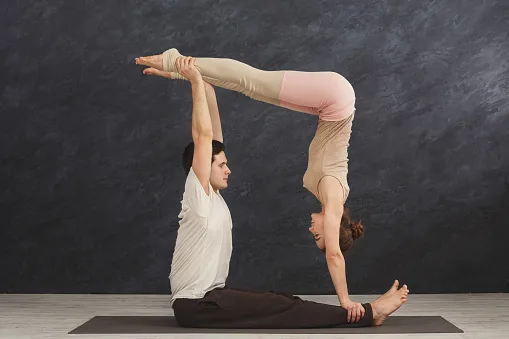Acro Yoga is a fascinating blend of traditional yoga, acrobatics, and Thai massage, embodying the essence of balance, strength, and mutual support. Originated by Jason Nemer and Jenny Sauer-Klein in 2003, Acro Yoga has taken the fitness world by storm.
Introduction to Acro Yoga
Acro Yoga is a physical practice that combines yoga, acrobatics, and Thai massage. It involves two participants – a base and a flyer – and often a spotter for safety. The base supports the flyer using their arms and legs while the flyer moves through a series of acrobatic yoga poses.
At first glance, the strength and balance required might make Acro Yoga seem challenging. However, once you delve into this unique form of yoga, you’ll find it’s accessible to beginners and offers therapeutic benefits that go beyond a simple workout. It’s a fantastic way to build core strength, increase flexibility, and enhance your yoga and acrobatics skills.
Why Choose Acro Yoga?
While traditional yoga is a solo practice, Acro Yoga is a partner yoga practice that allows you to engage and lean into the support of another person. It’s an incredible way to improve balance and strength while creating a deep connection with your partner. Whether you’re in a plank position or inverted, your partner is there to support and help you.
Besides physical strength, Acro Yoga also contributes to mental and emotional wellbeing. It fosters trust, communication, and a sense of playfulness. Practicing Acro Yoga requires the participants to fully engage in the present moment, making it a mindful, therapeutic activity.
Acro Yoga for Beginners: Getting Started
Before you jump into your first Acro Yoga session, it’s important to understand the roles of the base and the flyer. The base is the person on the bottom who provides the support. They usually lie on their back with legs and arms up, forming an “L shape” with the body. The flyer is the person supported by the base, moving into a series of poses such as front plank or folded leaf.
In addition to these roles, there’s a third role that beginners often overlook – the spotter. The spotter ensures the safety of the base and flyer, ready to assist or catch the flyer if they lose balance.
Acro Yoga Basic Poses
Acro Yoga Pose: The Plank
The plank is an excellent pose for beginners. The base lies on their back with their legs bent and feet in the air. The flyer places their hip on the base’s feet and leans forward, taking hold of the base’s hands. With the base’s support, the flyer lifts their legs off the ground and balances in a horizontal position similar to a traditional yoga plank.
This pose is beneficial for the base as well as it takes time to build strength in the arms and legs. Remember, the base needs to keep their arms and legs straight to properly support the flyer.

Acro Yoga Pose: Folded Leaf
Folded leaf pose offers a deep stretch for the flyer and helps the base build strength. The base starts in the same position as for plank, but this time, the flyer leans forward onto the base’s legs, letting their body hang relaxed.
The base supports the flyer’s body with their feet and offers a gentle massage by pressing on the flyer’s back with their hands. This pose is therapeutic flying at its finest – it’s incredibly relaxing and a wonderful introduction to the practice of Acro Yoga.

Acro Yoga Pose: The Throne Pose
Throne Pose is a beautiful beginner’s acro yoga pose where the flyer is seated on the base’s feet. The base lies on the ground, with their knees bent and feet in the air. The flyer sits on the base’s feet, engaging their core to maintain balance. The base supports the flyer by holding their hands.
This pose offers a great chance for the flyer to build balance and for the base to develop strength. It is also a fun and exciting pose that brings a sense of accomplishment when achieved.

Acro Yoga Pose: The Whale Pose
The whale pose is a beautiful, backbend acro yoga pose where the base lifts the flyer off the ground using their feet. The base places their feet on the flyer’s lower back while the flyer, facing upwards, grabs the base’s ankles. The flyer then leans back and extends their arms and legs upwards. This pose not only provides a deep stretch to the flyer’s body but also helps the base engage and strengthen their legs and core.

Benefits of Acro Yoga
The practice of Acro Yoga is more than just an exercise; it’s a comprehensive system that combines yoga, acrobatics, and healing arts, such as Thai massage, into a singular, powerful practice. It’s a gateway to myriad health benefits, impacting not only your body but also your mental and emotional wellness. From enhancing flexibility to relieving stress, here’s an in-depth look at the benefits of Acro Yoga.
Physical Benefits of Acro Yoga
- Strengthens Muscles and Joints: Acro Yoga helps develop strength throughout the body, particularly the arms, legs, and core. For instance, as a base, you need to maintain a solid base, keeping your arms straight and forming a “V shape” with your legs. This posture engages your core, hip muscles, and strengthens your shoulder blades and wrist.
- Increases Flexibility and Balance: Acro Yoga involves various poses where the flyer needs balance and flexibility. For example, in some acro yoga positions, the flyer is inverted and supported on the vertical legs of the base. The flyer’s torso and limbs stretch out, contributing to greater flexibility and balance.
- Improves Body Awareness and Alignment: Acro Yoga fosters a heightened sense of body awareness. The flyer and the base must remain acutely aware of their bodies’ alignment to maintain poses and ensure safety. Correct alignment is one of the most important aspects of Acro Yoga.
- Boosts Cardiovascular Health: The dynamic nature of Acro Yoga gets your heart pumping, providing a good cardiovascular workout. It enhances heart health and overall fitness.
Mental and Emotional Benefits of Acro Yoga
- Develops Trust and Communication: In Acro Yoga, one partner is often inverted while the other provides support. This creates a profound sense of trust and necessitates clear, open communication.
- Relieves Stress and Anxiety: Like traditional yoga, Acro Yoga can help reduce stress and anxiety. The physical activity, combined with mindful breathing and the inherent fun of the practice, fosters a sense of calm and well-being.
- Enhances Mindfulness and Focus: Acro Yoga requires a high level of focus. Practitioners need to stay fully present to maintain their balance and ensure their safety and their partner’s safety.
In conclusion, Acro Yoga is a rich, multidimensional practice that offers numerous physical, mental, and emotional benefits. Whether you’re seeking a fun and dynamic way to improve your fitness, or a practice that deepens trust, communication, and mindfulness, Acro Yoga has something to offer. As always, remember to warm up properly before your practice, and if you’re new to Acro Yoga, consider finding an experienced instructor to guide you.
The Role of Thai Massage in Acro Yoga
Thai massage plays a vital role in Acro Yoga, offering therapeutic benefits to the practice. By incorporating the principles of Thai massage, Acro Yoga can help release tension and promote relaxation in muscles. This can often be experienced in poses like the Folded Leaf, where the base uses their feet and hands to apply pressure on the flyer’s back and legs, mimicking the effects of a deep, relieving massage.
Tips to Improve Your Acro Yoga Practice
Like any physical practice, Acro Yoga takes time and effort to master. Here are some tips to improve your Acro Yoga practice:
- Stay Consistent: Consistency is key in Acro Yoga. It may take time to get the hang of certain poses or to build the strength and balance required. Remember, it’s not a race – take your time and enjoy the process.
- Communicate: Clear and open communication between the base and flyer is crucial. Always express if you’re uncomfortable or need to take a break.
- Be Mindful: Stay present during your Acro Yoga practice. Pay attention to your body and your partner’s body. This mindful approach will enhance your practice and deepen your connection with your partner.
Conclusion
AcroYoga is a wonderful practice that blends yoga, acrobatics, and Thai massage. It’s about balance, strength, and mutual support. Whether you’re a beginner just starting or an experienced yogi, Acro Yoga offers unique challenges and rewards. So why not give it a try? After all, as Jenny Sauer-Klein, the co-founder of AcroYoga, said, “In AcroYoga, we lift each other up, literally and figuratively. It’s about community and trust.”
Frequently Asked Questions about Acro Yoga
What is the difference between yoga and Acro Yoga?
Yoga is a physical, mental, and spiritual practice that originates from ancient India. It focuses on flexibility, strength, balance, and mindfulness, often through solo exercises. On the other hand, Acro Yoga combines traditional yoga with elements of acrobatics and healing arts. It involves more complex positions where one partner is often inverted and supported by the other. Here, the base bends their knees to support the flyer, allowing the flyer to experience a range of movement not possible in traditional yoga.
Is Acro Yoga for couples?
While Acro Yoga can be an excellent way for couples to bond, it is not exclusive to them. Any two people can practice Acro Yoga as it focuses on trust, communication, and teamwork. You don’t need to be in a romantic relationship with your partner; friends, siblings, or even strangers at an Acro Yoga class can make great partners.
What is Acro Yoga good for?
Acro Yoga offers numerous benefits, including building core and upper-body strength, enhancing balance, improving coordination, and boosting cardiovascular health. It also helps increase flexibility, particularly in the groin and hamstring when one foot makes contact with the ground during certain poses. Acro Yoga is also beneficial for mental health, fostering mindfulness, trust, and cooperation.
Can anyone do Acro Yoga?
Yes, anyone can start practicing Acro Yoga. While some poses may seem daunting at first, beginners can start with simple poses and gradually progress to more challenging ones. Remember, every person’s body is different, and it’s important to listen to your body and practice safely.
What are the roles in Acro Yoga?
There are typically three roles in Acro Yoga: the base, the flyer, and the spotter. The base is the person on the ground supporting the flyer, who performs acrobatic movements. The spotter ensures safety, observing and making corrections as necessary.
What is the difference between Acro Yoga and partner yoga?
While both practices involve two people, partner yoga primarily involves two people performing yoga postures together, enhancing and deepening each other’s experience. In contrast, Acro Yoga incorporates elements of acrobatics, where often, the base’s neck and upper back make a firm base, allowing the flyer to perform a variety of positions, even being entirely off the ground.
How hard is Acro Yoga?
The difficulty level of Acro Yoga can vary. Some poses can be easily learned in a single session, while others require practice over time. It’s crucial to communicate with your partner, maintain a wide stance for stability, and ensure a hip-distance gap when acting as the base. Over time, as your strength, flexibility, and coordination improve, you’ll find Acro Yoga becomes more comfortable and enjoyable.





















